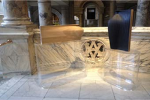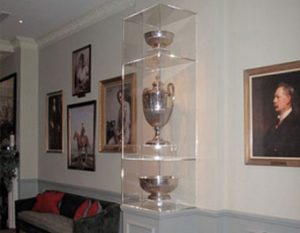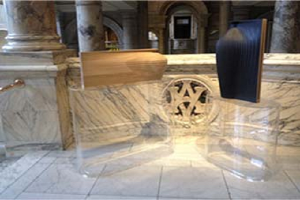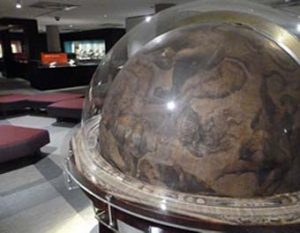How to Choose a Plastic Fabrication Company in London

Uncategorized
Choosing the right plastic fabrication company is crucial for ensuring your projects meet the highest standards of quality and precision. With numerous options available in London, it's essential to know what factors to consider and which companies stand out in the industry. One such company is Denny Plastics, renowned for our extensive experience and comprehensive range of services.
Key Factors to Consider
- Experience and Reputation
The first thing to look for is a company's experience and reputation in the industry. Companies with a long history are often more reliable and have a proven track record. Denny Plastics, for instance, has been a leader in the plastic fabrication industry for over 70 years. Our longstanding presence in the market is a testament to our expertise and commitment to quality.
- Range of Services
A company that offers a wide range of services can be more adaptable to your needs. Whether you require simple cut-to-size services or complex bespoke fabrication, it's advantageous to work with a company that can handle various tasks. Denny Plastics excels at providing diverse services, including:
- Plastic Cutting and Machining: Precision cutting, CNC routing, and laser cutting ensure your materials are shaped exactly as needed.
- Bespoke Fabrication: Custom fabrication services allow you to create unique products tailored to your specifications.
- Polishing and Finishing: High-quality polishing and finishing services give your products a professional and polished look.
- Thermoforming: This process involves heating plastic sheets until they are pliable enough to be moulded into specific shapes.
- Quality of Materials
The quality of materials used is critical for the durability and performance of the final product. Ensure the company uses high-grade materials and can source various types of plastics, including acrylic, polycarbonate, and PVC. Denny Plastics is known for sourcing top-quality materials, ensuring that every project meets the highest standards.
- Customer Service
Excellent customer service is essential for a smooth and satisfactory experience. A good company should be responsive, willing to answer questions, and provide expert advice. Denny Plastics prides itself on offering exceptional customer service, guiding clients through every step of the fabrication process.
- Turnaround Time and Reliability
Meeting deadlines is crucial for any project. A reliable plastic fabrication company should be able to provide realistic timelines and stick to them. At Denny Plastics, we are known for our punctuality and reliability, ensuring that projects are completed on time without compromising quality.
Why Choose Denny Plastics?
Denny Plastics stands out as a top choice for plastic fabrication in London due to our extensive experience, diverse services, and commitment to quality. Here are some reasons why you should consider them for your next project:
- Over 70 Years of Experience: Our long history in the industry speaks volumes about our expertise and reliability.
- Comprehensive Services: From cutting and machining to bespoke fabrication and thermoforming, they offer a full range of services to meet your needs.
- High-Quality Materials: They use only the best materials, ensuring that your products are durable and high-performing.
- Exceptional Customer Service: Our team is dedicated to providing excellent service, offering guidance and support throughout the project.
- Reliable Turnaround Times: They understand the importance of deadlines and work diligently to ensure the timely delivery of all projects.
Conclusion
Choosing the right plastic fabrication company in London requires careful consideration of various factors, including experience, range of services, quality of materials, customer service, and reliability. Denny Plastics excels in all these areas, making them a trusted partner for all your plastic fabrication needs. With our extensive experience and comprehensive services, you can be confident that your project will be executed to the highest standards. For more information about our services, get in touch with us today and discover how they can help bring your project to life.
What Does a Plastic Fabricator Do?

blogpost
When you think of plastic fabricators, what comes to mind? For many, the term might evoke images of factory machinery and mass production lines. However, plastic fabrication is an intricate craft, blending precision engineering with creative problem-solving. In this blog post, we'll delve into what plastic fabricators do, highlighting the skills, tools, and processes involved, as well as the benefits of using a professional fabricator for your projects.
The Role of a Plastic Fabricator
A plastic fabricator specialises in creating custom plastic products and components from raw plastic materials. This involves various processes, including cutting, shaping, forming, and assembling plastic to meet specific design and functional requirements. The end products range from everyday items to complex industrial components, demonstrating the versatility and importance of plastic fabrication in various sectors.
Key Processes in Plastic Fabrication
- Cutting and Routing
- Laser Cutting: Laser technology offers precision and clean edges, ideal for intricate designs and detailed work.
- CNC Routing: Computer Numerical Control (CNC) routing allows for automated and highly accurate cutting and shaping, crucial for consistency in production.
- Thermoforming
- Vacuum Forming: This process involves heating plastic sheets until pliable, then draping them over a mould and using vacuum pressure to form the desired shape.
- Pressure Forming: Similar to vacuum forming but utilises additional pressure for more detailed and defined features.
- Fabrication and Assembly
- Bending: utilising heat to bend plastic sheets into specific angles and curves without compromising the material's integrity.
- Bonding and Welding: Various techniques, including solvent welding and ultrasonic welding, are used to join plastic parts together seamlessly.
- Finishing and Polishing
- Flame Polishing: A method to smooth and clear the edges of plastic, enhancing its appearance and functionality.
- Buffing: Provides a high-gloss finish, making the final product visually appealing.
Skills and Expertise of a Plastic Fabricator
Plastic fabricators are skilled artisans and engineers. They must understand the properties of different plastics, such as acrylic, polycarbonate, and PVC, to choose the right material for each project. Their expertise extends to reading and interpreting technical drawings, working with advanced machinery, and applying precise craftsmanship to ensure every piece meets stringent quality standards.
Applications of Plastic Fabrication
The applications of plastic fabrication are vast, covering multiple industries:
- Retail: Custom displays, point-of-sale units, and signage.
- Medical: Equipment housings, protective barriers, and specialised components.
- Automotive: Prototype models, custom parts, and interior elements.
- Architectural: Skylights, interior design features, and bespoke installations.
Benefits of Using a Professional Plastic Fabricator
- Customisation: Professional fabricators can tailor products to exact specifications, ensuring they meet unique needs and preferences.
- Quality Assurance: Expert fabricators use high-grade materials and precise techniques, resulting in durable and reliable products.
- Efficiency: With access to advanced machinery and experienced personnel, professional fabricators can complete projects efficiently without compromising quality.
- Innovative Solutions: Skilled fabricators often provide innovative solutions to complex problems, offering design and functionality improvements.
Choosing the Right Plastic Fabricator
When selecting a plastic fabricator, consider their experience, portfolio, and the range of services they offer. A reputable fabricator like Denny Plastics combines decades of expertise with state-of-the-art technology, ensuring high-quality results for a diverse range of projects. In conclusion, plastic fabricators play a crucial role in transforming raw plastic materials into functional and aesthetically pleasing products. Their work is essential across various industries, providing customised solutions that meet specific needs. By understanding the processes and benefits of plastic fabrication, you can make informed decisions for your next project. Whether you're looking for bespoke retail displays or specialised industrial components, partnering with an experienced plastic fabricator ensures the success and quality of your product.
Transforming Spaces: The Art of Custom Plastic Fabrication for Retail Displays

blogpost
In the ever-evolving world of retail, creating captivating and immersive shopping experiences is essential for attracting and retaining customers. From eye-catching window displays to interactive product showcases, every element of a retail environment plays a crucial role in shaping the customer's perception and driving sales. One such element that has gained prominence in recent years is custom plastic fabrication for retail displays.
The Power of Visual Merchandising
Visual merchandising is the art of presenting products in a way that entices customers and stimulates their desire to purchase. It involves strategic placement, creative design, and attention to detail to create an engaging and memorable shopping experience. Custom plastic fabrication allows retailers to bring their vision to life and elevate their displays to new heights.
Versatility and customisation
One of the key advantages of custom plastic fabrication is its versatility and ability to be tailored to suit the unique needs and branding of each retailer. Whether you're looking to create sleek shelving units, striking product stands, or intricate signage, plastic fabrication offers endless possibilities for customisation. From the choice of materials to the design and finishing touches, every aspect of the display can be customised to reflect the brand's identity and vision.
Durability and Longevity
In addition to its aesthetic appeal, custom plastic fabrication offers durability and longevity, making it an ideal choice for retail displays. Unlike traditional materials such as wood or metal, plastic is lightweight, resistant to moisture and corrosion, and easy to clean, making it well-suited for high-traffic retail environments. With proper care and maintenance, plastic displays can withstand the test of time and continue to impress customers for years to come.
Seamless Integration of Technology
With advancements in technology, custom plastic fabrication now allows for the seamless integration of digital elements into retail displays. Whether it's incorporating LED lighting, interactive touch screens, or augmented reality features, retailers can create immersive and interactive experiences that captivate and engage customers. By combining physical and digital elements, retailers can create dynamic displays that tell a story, showcase products, and drive sales.
Elevating the Shopping Experience
Ultimately, custom plastic fabrication plays a crucial role in transforming retail spaces and elevating the shopping experience for customers. By investing in high-quality, custom-designed displays, retailers can create a visually stunning environment that draws customers in, encourages exploration, and ultimately leads to increased sales and brand loyalty.
In conclusion, custom plastic fabrication is a powerful tool for retailers looking to make a lasting impression and stand out in today's competitive marketplace. By harnessing the versatility, durability, and creative potential of plastic, retailers can create immersive and impactful displays that leave a lasting impression on customers and drive business success.
How Do You Manufacture Acrylic Products?

blogpost
Acrylic products have become ubiquitous in our daily lives, from household items to industrial applications. But have you ever wondered how these versatile and durable materials are manufactured? In this blog post, we'll take a deep dive into the manufacturing process of acrylic products.
Understanding Acrylic
Before delving into the manufacturing process, let's first understand what acrylic is. Acrylic, also known as polymethyl methacrylate (PMMA), is a synthetic polymer that offers transparency, weather resistance, and excellent optical clarity. It is commonly used as a substitute for glass due to its lightweight nature and impact resistance.
The Manufacturing Process
1. Raw Material Preparation
The manufacturing process of acrylic products typically begins with the preparation of raw materials. Acrylic is derived from petroleum-based products, primarily acrylic acid or its esters. These raw materials are then polymerized to form PMMA resin pellets, the basic building blocks of acrylic products.
2. Extrusion or Casting
Once the PMMA resin pellets are ready, they undergo either extrusion or casting, depending on the desired end product.
- Extrusion: In extrusion, the PMMA pellets are melted and forced through a die to form continuous shapes such as sheets, rods, or tubes. This process is ideal for producing long, uniform profiles with consistent thickness.
- Casting: Casting involves pouring liquid PMMA resin into molds, where it solidifies to take the shape of the mold cavity. This method is commonly used for producing intricate shapes, such as display cases or signage.
3. Heating and Shaping
After extrusion or casting, the acrylic material undergoes heating to relieve internal stresses and improve its mechanical properties. This step, known as annealing, helps reduce the risk of cracking or distortion during further processing.
4. Machining and Finishing
Once the acrylic material is annealed, it is ready for machining and finishing. This may involve cutting, drilling, milling, or polishing the material to achieve the desired shape, size, and surface finish. CNC (Computer Numerical Control) machining is often employed for precision cutting and shaping of acrylic parts.
5. Assembly (Optional)
In some cases, acrylic products may require assembly of multiple components to form the final product. This can involve techniques such as solvent welding, adhesive bonding, or mechanical fastening, depending on the design requirements.
6. Quality Control
Throughout the manufacturing process, rigorous quality control measures are implemented to ensure that the acrylic products meet the highest standards of performance and durability. This includes inspection of raw materials, monitoring of process parameters, and testing of finished products for dimensional accuracy, clarity, and strength.
Conclusion
The manufacturing process of acrylic products is a complex yet fascinating journey that involves transforming raw materials into finished goods with precision and care. From raw material preparation to machining, finishing, and assembly, each step plays a crucial role in shaping the final product's quality and performance.
Denny Plastics, with its expertise and state-of-the-art facilities, continues to lead the way in acrylic fabrication, providing innovative solutions to meet the diverse needs of industries and consumers alike. Whether it's custom displays, protective barriers, or architectural elements, acrylic products manufactured by Denny Plastics are synonymous with quality, reliability, and durability.
So, the next time you encounter an acrylic product, take a moment to appreciate the intricate craftsmanship and engineering behind its creation, knowing that it all started with a vision and a raw material.
What is Acrylic Dome Blowing?

blogpost
Acrylic dome blowing is a captivating and intricate process that combines artistry with scientific precision to create stunning domes used in various applications, from architectural design to underwater exploration. In this in-depth guide, we delve into the fascinating world of acrylic dome blowing, exploring its history, techniques, applications, and the underlying science behind this unique craft.
History of Acrylic Dome Blowing
The origins of acrylic dome blowing can be traced back to the mid-20th century, when acrylic, a versatile and durable thermoplastic, gained popularity in various industries. Initially used in military applications such as aircraft canopies due to its lightweight and shatter-resistant properties, acrylic soon found its way into civilian domains, including architecture and marine exploration.
Techniques of Acrylic Dome Blowing
Acrylic dome blowing involves several intricate techniques that require a combination of skill, precision, and specialised equipment. The process typically begins with the preparation of acrylic sheets, which are heated to a specific temperature to make them pliable. Once heated, the sheets are carefully manipulated using moulds or forms to achieve the desired dome shape. This shaping process requires expertise to ensure uniform thickness and structural integrity.
Applications of Acrylic Domes
The versatility and durability of acrylic make it ideal for a wide range of applications, and acrylic domes are no exception. These domes find use in architectural design, where they serve as skylights, observation decks, and architectural features, adding aesthetic appeal while allowing natural light to enter interior spaces. In the marine industry, acrylic domes are utilised in submersibles and underwater habitats, providing panoramic views of the ocean depths while withstanding the immense pressure exerted by water.
The Science Behind Acrylic Dome Blowing
At its core, acrylic dome blowing is a marriage of art and science, with the physical properties of acrylic playing a crucial role in the process. Acrylic, also known as polymethyl methacrylate (PMMA), exhibits excellent optical clarity, making it an ideal material for transparent structures like domes. Its high impact resistance and UV stability ensure durability and longevity, essential characteristics for applications exposed to harsh environments.
Furthermore, the thermoforming process involved in acrylic dome blowing relies on the material's thermal properties. By heating acrylic sheets to their softening point, they become malleable enough to be shaped into complex forms without compromising their structural integrity. The cooling process then solidifies the acrylic, locking it into the desired shape.
Conclusion
Acrylic dome blowing is a captivating blend of artistry and engineering, yielding visually stunning structures that serve diverse purposes across various industries. From architectural marvels to underwater exploration, acrylic domes continue to push the boundaries of design and innovation. As technology advances and materials evolve, the possibilities for acrylic dome blowing are limitless, promising a future filled with even more remarkable creations. Whether illuminating interiors with natural light or offering breathtaking views of the ocean depths, acrylic domes stand as testaments to human ingenuity and creativity.














